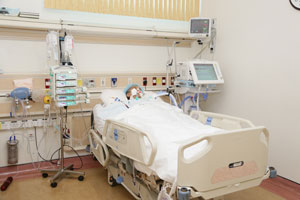- Home
- Editorial
- News
- Practice Guidelines
- Anesthesiology Guidelines
- Cancer Guidelines
- Cardiac Sciences Guidelines
- Critical Care Guidelines
- Dentistry Guidelines
- Dermatology Guidelines
- Diabetes and Endo Guidelines
- Diagnostics Guidelines
- ENT Guidelines
- Featured Practice Guidelines
- Gastroenterology Guidelines
- Geriatrics Guidelines
- Medicine Guidelines
- Nephrology Guidelines
- Neurosciences Guidelines
- Obs and Gynae Guidelines
- Ophthalmology Guidelines
- Orthopaedics Guidelines
- Paediatrics Guidelines
- Psychiatry Guidelines
- Pulmonology Guidelines
- Radiology Guidelines
- Surgery Guidelines
- Urology Guidelines
New test identifies serious secondary infection in critically ill patients

A team of researchers has identified three cell surface markers can predict the risk of potentially life-threatening secondary infection in the intensive care units patients. Additionally, they have also demonstrated a new test that could speed up the development of new therapies to help at-risk patients.
The markers identified are found on the surface of key immune cells: neutrophils (frontline immune cells that attack invading pathogens), T-cells (part of our adaptive immune system that seeks and destroys previously-encountered pathogens), and monocytes (a type of white blood cell).
The study was published in the journal Intensive Care Medicine.
Andrew Conway Morris, the Department of Medicine at the University of Cambridge, and colleagues conducted the study to confirm the ability of cellular markers associated with immune dysfunction to stratify risk of secondary infection in critically ill patients.
Patients in intensive care units are at significant risk of potentially life-threatening secondary infections, including from antibiotic-resistant bacteria such as MRSA and C. difficile.
Infections in intensive care units (ICU) tend to be caused by organisms, such as multi-resistant gram-negative bacteria found in the gut, that are resistant to frontline antibiotics. Treating such infections means relying on broad-spectrum antibiotics, which run the risk of breeding further drug-resistance, or antibiotics that have toxic side-effects.
Estimates of the proportion of patients in ICU who will develop a secondary infection range from one in three to one in two; around a half of these will be pneumonia. However, some people are more susceptible than others to such infections - evidence suggests that the key may lie in malfunction of the immune system.
"These markers help us create a 'risk profile' for an individual," explains Dr. Morris from the. "This tells us who is at greatest risk of developing a secondary infection.
"In the long term, this will help us target therapies at those most at risk, but it will be immediately useful in helping identify individuals to take part in clinical trials of new treatments."
Clinical trials for interventions to prevent secondary infections have met with mixed success, in part because it has been difficult to identify and recruit those patients who are most susceptible, say the researchers. Using this new test should help fine tune the selection of clinical trial participants and improve the trials' chances of success.
The Immune Failure in Critical Therapy (INFECT) Study examined data from 138 individuals in ICUs and replicated findings from a pilot study in 2013. Serial blood samples were taken, and three cell surface markers associated with immune cell dysfunction [neutrophil CD88, monocyte human leucocyte antigen-DR (HLA-DR) and percentage of regulatory T cells (Tregs)] were assayed on-site using standardized flow cytometric measures. Patients were followed up for the development of secondary infections.
The researchers tested the correlation of the presence of these markers with susceptibility to a number of bacterial and fungal infections. An individual who tests positive for all three markers would be at two to three times greater risk of secondary infection compared with someone who tests negative for the markers. The markers do not indicate which secondary infection an individual might get, but rather that they are more susceptible in general.
Key Findings:
- Reduced neutrophil CD88, reduced monocyte HLA-DR and elevated proportions of Tregs were all associated with subsequent development of infection.
- The burden of immune dysfunction predicted a progressive increase in the risk of infection, from 14% for patients with no dysfunction to 59% for patients with dysfunction of all three markers.
- The tests failed to risk stratify patients shortly after ICU admission but were effective between days 3 and 9.
A key part of enabling this study was to standardize how the research could be carried out across multiple sites, say the researchers. They used an imaging technique known as flow cytometry, which involves labeling components of the cells with fluorescent markers and then shining a laser on them such that they give off a light at different wavelengths. This has previously been difficult to standardize, but the researchers successfully developed a protocol for use, ensuring they could recruit patients from the four study sites.
"This study confirms our previous findings that three cell surface markers can predict the risk of subsequent secondary infection, demonstrates the feasibility of standardized multisite flow cytometry and presents a tool which can be used to target future immunomodulatory therapies," concluded the authors.
For more information click on the link: https://doi.org/10.1007/s00134-018-5247-0

Disclaimer: This site is primarily intended for healthcare professionals. Any content/information on this website does not replace the advice of medical and/or health professionals and should not be construed as medical/diagnostic advice/endorsement or prescription. Use of this site is subject to our terms of use, privacy policy, advertisement policy. © 2020 Minerva Medical Treatment Pvt Ltd